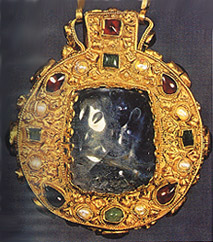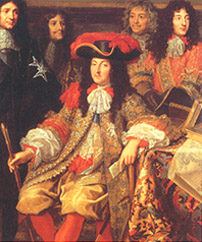

The French Crown Jewels
Written and researched by Margaret Odrowaz-Sypniewska, B.F.A.
 ...
... 
CHARLEMAGNE'S SAPPHIRE TALISMAN

Charlemagne had a sapphire talisman/amulet made for his wife by the sorcerers of the court of Haroun el Raschid, Emperor of the East. The talisman had two large cabochon sapphires. One was oval and the other was square. They were set into a remnant of the wood from the Holy Cross (the Cross of Jesus) and a small piece of the Virgin's hair. It was to make their love constant. It must have worked, since he never stopped loving her. This talisman was buried with him at Aix-la-Chapelle, in 814, and re-discovered when the tomb was opened by Otto III in 1000. The talisman was then preserved in the treasury of the Cathedral until it was given, by the canons, to Empress Josephine in 1804, to wear at her coronation.
Each side of the crown was set with a great cabochon [a polished gem that is not cut into facets] sapphire in a foliated [leaf-like] colate [compared in detial to] that rose from the rim of gold. The crown had lots of embossed [a raised design or relief] work and coarse filigree [ornamental openwork of fine wire] with settings of garnets, carbuncles, emeralds, and pearls.

In 1239, St. Louis bought this relic crown of thorns from the emperor of Constantinopole [formerly Istanbul, Turkey], and the St. Chapelle was built to house the previous relic. This crown is presently in the Louvre in Paris, France.

THE HOPE DIAMOND
Louis XIV, of France bought the gem later known as the "Hope Diamond," in 1668, from a French Trader named, Jean-Baptiste Tavernier. Tarvernier bought it from a French Trader, who came up missing on a trading trip. Later, his remains were found, and dogs were gnawing at his bones. The 44.5 carat diamond had originally been stolen from the Temple of Rama Sitra in Mandala, Burma, by an unknown thief.
This "blue" diamond weighed 112 carats. Louis purchased a total of twenty-two (22) diamonds from Tavernier, before his death. However, the king wanted to re-cut the blue diamond for more brilliance, which reduced it down to 67.50 carats. Louis had the gem cut into the shape of a heart for his mistress, Mme. de Montespan. She was accused of practicing black magic and the jewel was taken back to avoid attaching the stigma of her "crimes." Maria Antoinette, Louis' wife, then wore the same diamond and was beheaded during the French Revolution in 1793.
 ......
......
This stone was stolen during the French Revolution, and was never recovered. Although many think the Hope Diamond was cut from the "Blue Diamond of the Crown" of Louis. After this, the diamond made its way to Amsterdam (in 1830). A diamond cutter named Wilhelm Falls (or Fals), recut it into a setting with its present oval shape, and encircled it with smaller white diamonds and a diamond chain. Wilhelm's son, Hendrick, stole the diamond and then hung himself in guilt. The stone was returned to Wilhelm, who sold it to a banker named Henry Phillip Hope. In 1830, this diamond fetched the price of $90,000.00. The Hope family thought this diamond was cursed because Thomas Henry Hope lost his fortune after inheriting the stone. The necklace was given to his cousin, Lady Francis Hope. Wilhelm's wife blamed the diamond for the failure of their marriage. It was because of its second faceter (diamond cutter) that the diamond was named, "The Hope Diamond."
In 1904, a French diamond broker named Jacques Colot, bought the Hope Diamond and he committed suicide in an asylum, after he sold it to a Russian nobleman, Prince Kanilovsky, who in turn, gave it to his lover, Mademoiselle Ladue, a Folies Bergeres actress. Later, he ended up shooting Ladue and as he fled from the crime scene, he was stabbed, to death, in the street.
Merchant Habib Bey wanted to sell the diamond, but he drowned before he was paid.
Simon Montharides, a Greek dealer sold the Hope, and his carriage plunged off a cliff, killing himself, his wife, and their child.
In 1901, Abdul Hamid III, Sultan of Turkey, bought the Hope Diamond and an uprising began in his sultanate and he was de-throned.
Pierre Cartier, the famous broker of Cartier jewelers, bought the Hope and sold it to Evalyn Walsh McLean for $40,000.00. Ms. McLean was the daughter of a mining tycoon. She was said to have been miserable for the rest of her life. Her eight year old son was killed by a car, only one year after the purchase of the necklace. After her son's untimely and tragic death, her husband, Ned McLean (the publisher), took to drinking and died in an asylum.
In 1946, the couple's daughter took an overdose of sleeping pills and died. After Evalyn Walsh McLean's death, the diamond was left to her six grandchildren. Two years later, it was given to the Smithsonian Institute, in Washington, D.C. (USA) and it is now encased in heavy Plexiglas with a small viewing hole ... supposedly to protect those who might view the cursed stone. Under long wave UV light the gem is inert, but under short wave UV light it looks blue. When the UV stimulation is removed, it glows red like a hot coal.
Even though Evalyn's grandchildren wanted to rid themselves of the diamond, and its curse, it seems the diamond took yet another victim. In 1967, one of Evalyn's granddaughters was found dead after consuming alcohol and drugs. The Hope Diamond was said to have cursed all who possessed it.